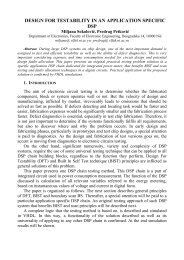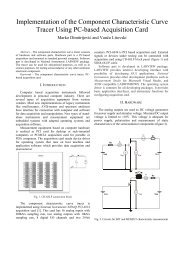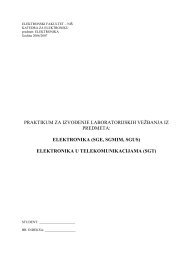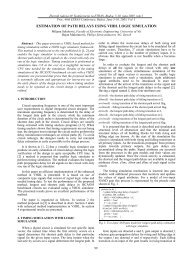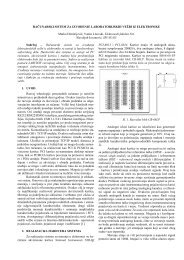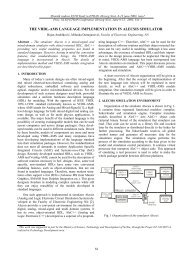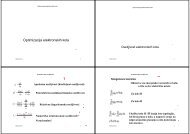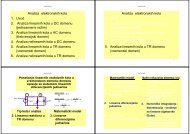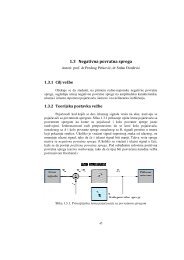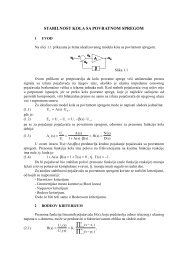6. Digital simulation in Alecsis - LEDA
6. Digital simulation in Alecsis - LEDA
6. Digital simulation in Alecsis - LEDA
Create successful ePaper yourself
Turn your PDF publications into a flip-book with our unique Google optimized e-Paper software.
<strong>6.</strong> <strong>Digital</strong> <strong>simulation</strong> <strong>in</strong> <strong>Alecsis</strong> 85• creat<strong>in</strong>g new logic truth tables,• overload<strong>in</strong>g of appropriate logic operators, to accept l<strong>in</strong>ks of the new type• if model cards are to be used, declarations of model class and def<strong>in</strong>ition of methods are necessary.In this way basis for <strong>simulation</strong> with new logic system is created, which can be used for creation of models.<strong>6.</strong>1.1. Systems of statesSystem of state of a simulator describes legal states of a digital simulator. Total number of these states iscalled the card<strong>in</strong>al number of the simulator. Many simulators have a built-<strong>in</strong> system of state. <strong>Alecsis</strong> does not havesuch a system, and it needs to be def<strong>in</strong>ed before the <strong>simulation</strong> (often used systems are available <strong>in</strong> the library).You need to use enumeration types to def<strong>in</strong>e the system of state. To allow for representations of digitalwords (vectors), system of state needs to be def<strong>in</strong>ed with characters as symbols. Examples are:typedef enum { 'x', '0', '1' } three_t; //system with 3 statestypedef enum { 'x', '0', '1', 'z' } four_t; //system with 4 statestypedef enum { ' '=void, '_'=void,'x', 'X'='x', '0', '1', 'z', 'Z'='z'} four_t;The last example def<strong>in</strong>es a type with 4 states, two types of separators for enumeration str<strong>in</strong>gs, and is case<strong>in</strong>sensitive.Enumeration types <strong>in</strong> AleC++ occupy 1 byte (char), tak<strong>in</strong>g that the <strong>in</strong>dexes of symbols are <strong>in</strong> range -128to 127, otherwise they take 2 bytes.Term "system of states" is used conditionally, s<strong>in</strong>ce the construct typedef merely def<strong>in</strong>es a new name fora enumeration set. Thus, an unlimited number of different "systems of states" can exist on the global levelsimultaneously, tak<strong>in</strong>g the names are different.The order of symbols <strong>in</strong> the set is important for three reasons:• If sets are non-<strong>in</strong>itialized, values are given as <strong>in</strong> C/C++ - start<strong>in</strong>g from value 0 for the first signal.• Order of states is important for creat<strong>in</strong>g truth tables of logic functions;• Signals (digital l<strong>in</strong>ks) that are not <strong>in</strong>itialized, have the start<strong>in</strong>g value that is the first symbol <strong>in</strong> the set. In ourexample, all signals <strong>in</strong> the circuit of type three_t and four_t that are not <strong>in</strong>itialized will have start<strong>in</strong>gstate 'x', s<strong>in</strong>ce 'x' is the first symbol <strong>in</strong> the set (separators do not count). Therefore, undef<strong>in</strong>ed state 'x'should be always the first symbol, as it is usual to treat non-<strong>in</strong>italized signal as undef<strong>in</strong>ed when the <strong>simulation</strong>beg<strong>in</strong>s.<strong>6.</strong>1.2. Truth tablesAleC++ has basic b<strong>in</strong>ary logic operators needed for logical <strong>simulation</strong>. However, they accept <strong>in</strong>tegeroperands, not enumeration ones. This means that for every new system of state we have to def<strong>in</strong>e truth tables for alloperators. Truth tables for unary operators are vectors of length N, for b<strong>in</strong>ary -- matrices NxN, where N is thenumber of states <strong>in</strong> the actual system of states (the card<strong>in</strong>al number).const three_t nottab[] = { 'x', '1', '0' };// x 0 1const three_t andtab[][3] = { { 'x', '0', 'x' }, // x{ '0', '0', '0' }, // 0
86 <strong>Alecsis</strong> 2.3 - User’s manual{ 'x', '0', '1' } // 1};<strong>6.</strong>1.3. Overload<strong>in</strong>g of operatorsThis tables alone are sufficient, and can directly be used for modell<strong>in</strong>g of a digital circuit. It may be better,however to use operator overload:<strong>in</strong>l<strong>in</strong>e three_t operator~ (three_t op) { return nottab[op]; }<strong>in</strong>l<strong>in</strong>e three_t operator& (three_t op1, three_t op2){ return andtab[op1][op2]; }foo () {three_t x = '1', y = '0', z = '1', r;}r = ~(x & y & ~z);Overloaded operators are very simple functions, which use truth tables, and return whatever was on aparticular position. Be<strong>in</strong>g so short, they are suitable to be <strong>in</strong>l<strong>in</strong>e. It is usual for that def<strong>in</strong>ition of an <strong>in</strong>l<strong>in</strong>eoperator to be <strong>in</strong> the same file with the def<strong>in</strong>ition of the system of states. That file can be <strong>in</strong>cluded as a header file<strong>in</strong>to a new file, where circuit description is, us<strong>in</strong>g <strong>in</strong>clude command:# <strong>in</strong>clude Table declaration can be <strong>in</strong> the same file (as extern), but the def<strong>in</strong>ition (with the <strong>in</strong>itialization) ought to be <strong>in</strong> aseparate file. That may be a file stor<strong>in</strong>g all def<strong>in</strong>itions for a particular system of states, and can be compiled <strong>in</strong>to alibrary (us<strong>in</strong>g -c option), by <strong>in</strong>vok<strong>in</strong>g:alec -c def<strong>in</strong>ition_file.acThat library can be used later by <strong>Alecsis</strong> l<strong>in</strong>ker. If the user prefers common, and not <strong>in</strong>l<strong>in</strong>e operators, than thedeclaration of the operators rema<strong>in</strong>s <strong>in</strong> header file, and their def<strong>in</strong>itions are compiled together with table def<strong>in</strong>itions.As you can see, the <strong>in</strong>tention is use C/C++ programm<strong>in</strong>g style - to group the declaration <strong>in</strong>to one header file that canbe <strong>in</strong>cluded when necessary, while the def<strong>in</strong>itions are compiled and stored as library.Assignment operators can be also overloaded. It stores the result of a logical operation <strong>in</strong>to the left operand(&=). The left operator need to be passed by reference to the operator function:<strong>in</strong>l<strong>in</strong>e three_t operator &= (three_t& op1, three_t op2){ return (op1 = andtab[op1][op2]); }<strong>6.</strong>1.4. Overload<strong>in</strong>g operators for vectorsAll logic operators can be overloaded for a new system of state us<strong>in</strong>g appropriate tables. Nevertheless, if youwant <strong>simulation</strong> on RT level (RTL -- register transfer level), you need to have operators for vector-operandsoverloaded, too. To make that possible, operator function needs to posses <strong>in</strong>formation about the vector dimension.A mechanism that is used for str<strong>in</strong>gs (strlen function) cannot be used. Symbols <strong>in</strong> systems of state can have avalue of '0', which renders the mechanism of classical str<strong>in</strong>gs (with '\0' as an n+1 element) <strong>in</strong>operable. Forthat reason, AleC++ has a special operator lengthof, which does not exist <strong>in</strong> C/C++.
<strong>6.</strong> <strong>Digital</strong> <strong>simulation</strong> <strong>in</strong> <strong>Alecsis</strong> 87<strong>6.</strong>1.4.1. Operator lengthofThis operator is syntactically very similar to the operator sizeof. It is a unary operator whose operandneeds to be a vector of enumeration type. (vector of signals or vector of variables). The vector can be a formalvariable, local variable, or a formal/local signal. In the case of a formal variable, AleC++ passes as a hiddenparameter the length of the actual argument extracted by the operator. The situation is much simpler with signals --a special <strong>in</strong>struction of the <strong>Alecsis</strong> virtual processor that returns the length of the signal-vector. Note that operand oflengthof operator cannot be a local po<strong>in</strong>ter, because lengthof would return 0 <strong>in</strong> that case.If a vector is declared with <strong>in</strong>verse dimensionality, the lengthof returns the negative value of its length.Usually, for overload<strong>in</strong>g vector-operands, you need the absolute value of the length. Direction can have animportant role with some specific operators (left shift<strong>in</strong>g >).three_t v1[0:3], v2[3:0];<strong>in</strong>t L1 = lengthof (v1); // L1 is 4<strong>in</strong>t L2 = lengthof (v2); // L2 is -4<strong>6.</strong>1.4.2. Buffers for temporary solutionsLogical operators often return a result, that can itself be an operand <strong>in</strong> a more complex expression. S<strong>in</strong>ce weare deal<strong>in</strong>g with a vector, a temporary memory location needs to be reserved for the result, and another temporarymemory to prevent the overwrite of that result by the new operation. The follow<strong>in</strong>g example illustrates this:# def<strong>in</strong>e Vreturn(v,size) {asm movq.l %d4, size; return v; }# def<strong>in</strong>e BUFF_SIZE 512three_t _op_buff[BUFF_SIZE], _res_buff[BUFF_SIZE];three_t *operator& (three_t *op1, three_t *op2) {<strong>in</strong>t size1 = abs (lengthof op1);<strong>in</strong>t size2 = abs (lengthof op2);if (size1 != size2) {pr<strong>in</strong>tf("<strong>in</strong>compatible lengths - op &, type three_t\n");exit(1);}for (<strong>in</strong>t i=0; i< size1; i++) _op_buff[i] = op1[i] & op2[i];memcpy(_res_buff, _op_buff, size1);Vreturn(_res_buff, size1)}three_t *operator= (three_t *op1, three_t *op2) {<strong>in</strong>t size = abs(lengthof op1);memcpy(op1, op2, size);memcpy(_res_buff, op1, size);Vreturn(_res_buff, size)}foo () {static three_t v1[]="0100", v2[]="11x0", v3[4], v4[4];v4 = v3 = v1 & v2;}The example illustrates a concept of us<strong>in</strong>g two buffers -- one for calculations, the other for the return of theresult. In this particular example use of only one buffer would be a satisfactory solution. However, <strong>in</strong> some morecomplex operations it may happen for one of the operands to be a result of an overload operation, which may meanthat we are read<strong>in</strong>g and chang<strong>in</strong>g the same vector simultaneously. That may produce errors that are very difficult to
88 <strong>Alecsis</strong> 2.3 - User’s manualdebug. It is better to use two buffers - the result is formed <strong>in</strong> _op_buff buffer, and is then copied <strong>in</strong>to_res_buff buffer.The return of a vector is rather uncommon -- we have used our macro Vreturn. Macro Vreturn returnsnot only the po<strong>in</strong>ter to a vector, but also its length, which enables later usage of command lengthof. FromVreturn, usual command return is <strong>in</strong>voked as:return v;where po<strong>in</strong>ter v is returned. Po<strong>in</strong>ter is stored <strong>in</strong>to lower register of the virtual processor accumulator %d0. Butbefore <strong>in</strong>vok<strong>in</strong>g usual command return, we have stored the length of the vector <strong>in</strong>to %d4 (the higheraccumulator register). Assembler command is used for that. If this result is passed to a function as an operator,operator lengthof can determ<strong>in</strong>e the vector length from this higher register. Macro Vreturn is available <strong>in</strong>the standard header file "alec.h").With a similar overload of operator =, you can handle enumeration vectors the same way as ord<strong>in</strong>arynumbers. Therefore, the user of the logic simulator, which has a library already prepared, can be unaware of bothlengthof operator and temporary buffers, as <strong>in</strong> function foo <strong>in</strong> the example above.It is up to the designer if he or she is go<strong>in</strong>g to allow for the comb<strong>in</strong>ation of vectors of different length and/ordifferent direction <strong>in</strong> such b<strong>in</strong>ary operators.Unary operators of left and right shift (>) can be overloaded <strong>in</strong> this manner, as well as <strong>in</strong>crement,and decrement (++ and --), etc.<strong>6.</strong>2. Synchronization of digital processesSuch program support, consist<strong>in</strong>g of prepared systems of states, logic truth tables, and appropriate operatorsis now available to model digital components. On the other hand, we have available an <strong>in</strong>ternal <strong>Alecsis</strong> discreteeventselective-trace <strong>simulation</strong> eng<strong>in</strong>e, that is able to manage the logic events. The construct discrete-event meansthat the simulator does not solve the time-cont<strong>in</strong>uum, but only time <strong>in</strong>stants when a logic event (change of logicstate) happens. Outside of these time-<strong>in</strong>stants, there are no changes <strong>in</strong> the circuit, i.e. noth<strong>in</strong>g for the simulator tosolve. Selective-trace means that only some models are executed when an event happens. When an event isgenerated at the output signal of some digital component, it activates only those components where the same signalacts as <strong>in</strong>put. Therefore, there is no need to simulate the whole circuit, only activated components (models) aresimulated. Therefore, we can consider execution of logic <strong>simulation</strong> as execution of synchronized processes, andtransmission of messages via signals.When we are def<strong>in</strong><strong>in</strong>g digital models, we are us<strong>in</strong>g the program support from the library. We have to providethe <strong>in</strong>formation for the <strong>simulation</strong> eng<strong>in</strong>e how to synchronize the processes. Here is an example:module and2 (three_t <strong>in</strong> a, b; three_t out y) {action (double delay) {process (a, b) { y
<strong>6.</strong> <strong>Digital</strong> <strong>simulation</strong> <strong>in</strong> <strong>Alecsis</strong> 89<strong>6.</strong>2.1. Interpretation of signals <strong>in</strong> expressionsThe name of a signal can legally appear <strong>in</strong> the expressions of the process. (Be aware about the mask<strong>in</strong>g rulesgiven <strong>in</strong> the previous chapter.) However, they must be treated differently than C/C++-like variables. L<strong>in</strong>ks, andtherefore signals as digital l<strong>in</strong>ks, are complex entities, which can be differently treated <strong>in</strong> different situations. Thetreatment of the signal depends on the context.In all non- assignment expressions, the name of the signal refers to the memory stor<strong>in</strong>g the current valueof the signal. The size, dimensionality, and the type of the memory depend upon the type of the signal (scalars,vector, or a structure). In other words, <strong>in</strong> such expressions, the name of the signal refers to it value - it is used as avariable.Signals must not appear on the left side of the assignment operator (such as =, =+, ++, etc.) s<strong>in</strong>ce theyare not l-values. The change of the signal value can be performed exclusively us<strong>in</strong>g a special AleC++ assignmentoperator for signals
90 <strong>Alecsis</strong> 2.3 - User’s manual<strong>6.</strong>2.2. Conversion of l<strong>in</strong>k typeIf a l<strong>in</strong>k has more than one aspect, i.e. it is both digital and analogue, the operator of l<strong>in</strong>k type conversioncan solve the ambiguity. This operator is very similar to C/C++ cast operator used for type conversion.signal s;action {process {double s_as_node;s_as_node = (node)s;}}We can perform l<strong>in</strong>k type conversion by stat<strong>in</strong>g (<strong>in</strong> parentheses) the desired type before the signal name.Priority and the associat<strong>in</strong>g rules of this conversion operator is the same as was with cast operator.Note: A wrong assumption that signal s possesses analogue aspect will result <strong>in</strong> a usually harmless value of0 dur<strong>in</strong>g the <strong>simulation</strong>. However, if we try the reverse, to convert the node <strong>in</strong>to a signal, where the node does nothave digital aspect, effect can be harmful.<strong>6.</strong>2.3. Conditional process suspension -- command waitWe have already said <strong>in</strong> the previous chapter that a process can be synhronized by giv<strong>in</strong>g the list ofsignals it is sensitive to. Another method of synchroniz<strong>in</strong>g a process is us<strong>in</strong>g command wait. Commandwait suspends the current process for a period of time, giv<strong>in</strong>g t the same time conditions for its reactivation.wait_command:wait ;An empty command is also legal:wait;In this case, the process is suspended until the end of the <strong>simulation</strong>. The sensitivity_list is the same listof signals that can be def<strong>in</strong>ed <strong>in</strong> the process head<strong>in</strong>g (the process us<strong>in</strong>g wait command must not besynchronized us<strong>in</strong>g some other method). The process execution stops at the wait command, until an eventhappens to some of the signals the command is sensitive to. If suspension_condition is given, it has to become zero,if the process is to activate, regardless of the events on some of the signals from the sensitivity_list. If time_outis def<strong>in</strong>ed, all of that can last up to time_out seconds.enum Edge { Ris<strong>in</strong>gEdge, Fall<strong>in</strong>gEdge };module (three_t <strong>in</strong> clock) {action (Edge mode) {process {...switch (mode) {case Ris<strong>in</strong>gEdge:wait clock while clock != '1' for 100ns;break;case Fall<strong>in</strong>gEdge:wait clock while clock != '0';break;}
<strong>6.</strong> <strong>Digital</strong> <strong>simulation</strong> <strong>in</strong> <strong>Alecsis</strong> 91}}}// code activates at the edge of clock signal...In this example, wait command is sensitive to the clock signal, with the condition of a transition to '1' (ifaction parameter mode equals Ris<strong>in</strong>gEdge) or '0' (if mode equals Fall<strong>in</strong>gEdge). The appropriateedge of the clock activates the code that follows (omitted <strong>in</strong> the example above). At the end of the process, thecontrol is back at its beg<strong>in</strong>n<strong>in</strong>g, and the execution stops aga<strong>in</strong> at wait command, wait<strong>in</strong>g the appropriate clockedge.<strong>6.</strong>2.4. Predef<strong>in</strong>ed signal attributesAll signals, regardless of their data type, have a number of attributes, whose value can be accessed <strong>in</strong> aprocess. All attributes are of <strong>in</strong>t type, and can be accessed us<strong>in</strong>g <strong>in</strong>direction operator -> (signal name istreated as a po<strong>in</strong>ter, i.e. address <strong>in</strong> memory). Signal attributes are:− active -- 1 if the signal is active <strong>in</strong> the present moment, otherwise 0− event -- 1 if an event is currently happen<strong>in</strong>g on the signal, otherwise 0− quiet -- 1 if the signal is not processed <strong>in</strong> the present moment (!active), otherwise 0− stable --1 if the signal is not chang<strong>in</strong>g value (!event), otherwise 0− fan<strong>in</strong> -- number of processes sensitive to this signal− fanout -- number of drivers of this signal− hybrid -- 1 if the signal has also analogue aspect, otherwise 0It can happen that the signal is processed, but the result is the same value as it was before.Processed signal is active, while an event happened to it only when the new value is differentfrom the old one. The term sensitivity has already been expla<strong>in</strong>ed, while the concept of driverswill be expla<strong>in</strong>ed <strong>in</strong> the follow<strong>in</strong>g section. The last attribute <strong>in</strong>dicates the hybrid aspect of thepresent signal, that is the coupl<strong>in</strong>g of analogue elements (which can have effect on delaycalculations and other activities).Note: The <strong>in</strong>direction operator -> can be used without restrictions, s<strong>in</strong>ce the members ofsignals-structures can be accessed us<strong>in</strong>g character '.', and the signal cannot be declared as apo<strong>in</strong>ter.Composite signals have attributes active, event, quiet, and stable. Attributes hybrid,fan<strong>in</strong>, and fanout are not allowed it the signal is not a scalar. Attributes active and event are obta<strong>in</strong>edas a result of or operation on attributes of all scalars of the signal (for example, a vector is active if at least oneposition is active). Attribute quiet is negation of active, and stable is negation of event.signal four_t v[4];...v[0]->fan<strong>in</strong>; // o.k.v->fan<strong>in</strong>; // error - composite signals cannot that attributeWe use attributes <strong>in</strong> the follow<strong>in</strong>g example for detection of static hazard - simultaneousand opposite change of the <strong>in</strong>puts of an AND circuit).
92 <strong>Alecsis</strong> 2.3 - User’s manualmodule and2 (three_t <strong>in</strong> a,b; three_t out y) {action (double delay) {process (a,b) {if (a->event && b->event && a != b)warn<strong>in</strong>g ("static hazard at <strong>in</strong>puts of AND2 circuit");y
<strong>6.</strong> <strong>Digital</strong> <strong>simulation</strong> <strong>in</strong> <strong>Alecsis</strong> 93}s3[1][0]
94 <strong>Alecsis</strong> 2.3 - User’s manualThis type of arrangement of future events agrees with the behaviour of real digital components. The eventcaused by a short-lived impulse will be erased <strong>in</strong> the case if <strong>in</strong>ertial delay before its time comes, so the componentthat owns the driver will not react to the impulse.Simulator constantly controls the time of the first event on the list of every driver. If the time agrees with thepresent moment, the value of that event becomes the new value of the driver. In order for the new value of driver tobecome the new value of the signal, at least one of the two conditions needs to be met:• Signal has only one driver;• Signal has an appended resolution function, which will resolve the f<strong>in</strong>al value fromdriver values.<strong>6.</strong>2.5.3. Resolution of conflicts on the bus (resolution function)A signal with two drivers gives rise to wired logic. We can approximate a number of outputs of digitalcircuits us<strong>in</strong>g voltage sources with their output resistances. By superimpos<strong>in</strong>g these sources, we can arrive at theresult<strong>in</strong>g value at a node. If the output resistances differ significantly, the result<strong>in</strong>g value <strong>in</strong> a node is the result ofthe source with the smallest output resistance. Speak<strong>in</strong>g <strong>in</strong> wired-logic terms, signals can, beside the state, have<strong>in</strong>tensity. The follow<strong>in</strong>g conditions need to be met if the simulator is to model wired logic:• System of states has to have a state of high impedance, <strong>in</strong>dicat<strong>in</strong>g that the driver iscurrently off-l<strong>in</strong>e;• Every multiple-driver signal has to have a resolution function.typedef enum { 'x', '0', '1', 'z' } four_t;four_t bus4res (const four_t *drv, <strong>in</strong>t *report) {<strong>in</strong>t ndrivers = lengthof drv;four_t result = drv[0];for (<strong>in</strong>t i=1; i 1 && result == 'x') *report = 1;return result;}signal four_t:bus4res bus[3:0];signal four_t:bus4res l<strong>in</strong>e = '0';Function bus4res given above makes the resolution for the system of four states. If at least only onedriver is 'x' (undef<strong>in</strong>ed), the result is also 'x'. If none of the drivers is 'x', but there are at least two of themhav<strong>in</strong>g different logic values '0' and '1', the result is aga<strong>in</strong> 'x', as there are two drivers with different valuesand high <strong>in</strong>tensity. The wired logic is normally used when only one driver drives the bus, which means that allothers are at high impedance state 'z', that is, have weak <strong>in</strong>tensity.
<strong>6.</strong> <strong>Digital</strong> <strong>simulation</strong> <strong>in</strong> <strong>Alecsis</strong> 95The resolution function is a global function fulfill<strong>in</strong>g certa<strong>in</strong> conditions regard<strong>in</strong>g results and parameters. If asignal is of l<strong>in</strong>k (signal) data type T, its resolution function will return the same type. The function has to have twoparameters, a po<strong>in</strong>ter to data type T, and a po<strong>in</strong>ter to <strong>in</strong>t type. The former is a vector of <strong>in</strong>stantaneous values of alldrivers of a signal, and the second is a flag <strong>in</strong>dicator. This flags conveys whether the resolution needs to report aconflict on the bus or not (the flag needs to be set to 1 for the message to appear).An association of a signal and its resolution function is obta<strong>in</strong>ed on signal declaration, if the character ':' andthe name of the resolution function are listed after the signal data type. Another way is to create new type (us<strong>in</strong>gtypedef) that <strong>in</strong>cludes the resolution function:four_t bus4or (const four_t *drv, <strong>in</strong>t *report);four_t bus4and (const four_t *drv, <strong>in</strong>t *report);typedef four_t:bus4or four_t_or; // new, resolved type fout_t_ortypedef four_t:bus4and four_t_and; // second versiontypedef struct {four_t send, recv;four_t:bus4and data[3:0];}:bus4or Connector;The last example shows the application of the resolution function <strong>in</strong> case of structures. The whole structurehas a resolution function bus4or, which is applied on members send and recv. However, structure memberdata has its own resolution function bus4and.For one system of states, you can def<strong>in</strong>e a desired number of resolution functions, e.g wired-AND, wired-OR. For system of states with high number of states it can be useful to create tables of resolutions as arrays.If a signal has one driver, and its resolution function is def<strong>in</strong>ed, it is applied. However, signal with one driverneeds not a resolution function. In such case, driver value is copied to the signal.<strong>6.</strong>2.5.4. Driver <strong>in</strong>itializationIf the system of states beg<strong>in</strong>s with 'x' (the first enumerated symbol is <strong>in</strong>dexed as 0), all non-<strong>in</strong>itializedsignals <strong>in</strong> the circuit would be set to 'x' at the beg<strong>in</strong>n<strong>in</strong>g of the <strong>simulation</strong>. For most of the cases, this is naturalchoice, as 'x' denotes undef<strong>in</strong>ed state. Nevertheless, for modell<strong>in</strong>g of switch<strong>in</strong>g logic this can be a problem.Transmission gate (switch) is actually a MOS transistor, and drivers for source and dra<strong>in</strong> would be set to 'x' evenif the gate is open. Such transmission gates are usually used for connections to the bus. Undef<strong>in</strong>ed state 'x' on anydriver of the bus means usually that the state 'x' would be resolved for the whole bus. However, correct model ofreal circuit behaviour demands that an open switch means that bus is driven with high impedance state, 'z'.The solution is found by <strong>in</strong>itialization of formal signals.module tgate (four_t <strong>in</strong> gate; four_t <strong>in</strong>out dra<strong>in</strong>='z', source='z');If formal signals have direction <strong>in</strong> or <strong>in</strong>out, and an <strong>in</strong>itial value is given, then all drivers created by theprocesses of that module will have that <strong>in</strong>itial value.The problem can arise with <strong>in</strong>itialization of multidimensional-array-signals. Their first dimension can beunknown, as they are formal signals, so one cannot utilize aggregate <strong>in</strong>itial array of values with fixed length. In suchcases, one can use operator
96 <strong>Alecsis</strong> 2.3 - User’s manualIn the above example, all drivers created by processes of module X, for all <strong>in</strong>dexes of vector y, will be <strong>in</strong>'z' state, whatever the size of the actual signal that corresponds to the formal signal y is.<strong>6.</strong>2.5.5. Complex delayThere are many ways of modell<strong>in</strong>g delay <strong>in</strong> logic simulators (unified, assigned, rise-fall, static, etc.). Whenthe delay is not a predef<strong>in</strong>ed value, the best way is to express it as a result of a function. If the function is not toolong, you can def<strong>in</strong>e it as <strong>in</strong>l<strong>in</strong>e:double fdelay (three_t new_value, double tplh, double tphl) {if (new_value=='0') return tphl;if (new_value=='1') return tplh;return tplh > tphl ? tplh : tphl;}...process (a,b) {three_t res = a & b;y
<strong>6.</strong> <strong>Digital</strong> <strong>simulation</strong> <strong>in</strong> <strong>Alecsis</strong> 97Note: One can use attributes to pass <strong>in</strong>formation between processes. However, this cannot be a correct modelof real circuit behaviour. Therefore, attributes should not be used as another way of communication betweenprocesses. You should set their values <strong>in</strong> the preparation phase of the <strong>simulation</strong>, and later only use these values.Application of user-def<strong>in</strong>ed attributes will be illustrated on the problem of capacitance modell<strong>in</strong>g <strong>in</strong> thedigital circuit. Delay of a digital circuit depends l<strong>in</strong>early (as the first approximation) on the capacitance connected toits output. Capacitances <strong>in</strong> a digital system are <strong>in</strong>put/output (term<strong>in</strong>al) capacitances of the circuit, and the parasiticcapacitances of connections (l<strong>in</strong>ks). The former can be considered as module parameters, and passed as such tomodules. The later need to be connected to signals. This makes connection capacitance an ideal candidate for asignal attribute. These capacitances cannot be changed dur<strong>in</strong>g the <strong>simulation</strong>, which means we should declare anattribute of as signal as a class, whose private member is a total capacitance of the signal. The capacitance value willcome out <strong>in</strong> the preparatory phase of the <strong>simulation</strong>. Dur<strong>in</strong>g the <strong>simulation</strong> run, it will be used for calculation of themodule delay.typedef enum { 'x', '0', '1', 'z' } four_t;class four_att {double Tcap; // total capacitance of the signalpublic:four_att (double cap=0.0) { Tcap = cap; } // constructorvoid add_tcap(double cap) { Tcap += cap; }double tcap () { return Tcap; }};typedef four_t @ four_att four_full;The memory is allocated for local signals only -- formal signals just denote connections to other signals,which are declared as local <strong>in</strong> some modules that are on higher hierarchy levels. Therefore, constructor for attributesis activated with arguments that are given <strong>in</strong> local signal declaration.four_t @ four_att(0.2p) bus;four_full(0.1p) l<strong>in</strong>e[3:0];This way of declaration gives certa<strong>in</strong> capacitance to the signal (parasitic capacitance). The best moment fortotal capacitance calculation is after form<strong>in</strong>g of the hierarchical tree. Therefore, process synchronized aspost_structural should be used:module and2 (four_full a, b; four_full out y) {action (double C<strong>in</strong>, double delay, double skew) {process post_structural {(@a)->add_tcap (C<strong>in</strong>);(@b)->add_tcap (C<strong>in</strong>);}process (a, b) {y tcap();...}}}In every component of type and2, signals a and b would have <strong>in</strong>put capacitance C<strong>in</strong> (passed as actionparameter) added. In reality, formal signals a and b are just connections (other names) to some actual signalselsewhere, that have that <strong>in</strong>put capacitance added. Parameter skew is the coefficient of <strong>in</strong>crease of total delay withthe <strong>in</strong>crease of capacitance load at the output. Therefore, multiply<strong>in</strong>g value skew with the total capacitance of thesignal y, we get the delay added to the parameter delay (parameter delay is the delay when the output is notloaded with capacitances). Therefore, the total logic circuit's delay depends on fan<strong>in</strong> (the number of modulesl<strong>in</strong>ked to the output). We cannot access the value of capacitance, s<strong>in</strong>ce it is declared as private. By the use of an
98 <strong>Alecsis</strong> 2.3 - User’s manualadditional mechanism, we can ban the use of add_tcap method, and thus fix term<strong>in</strong>al capacitance to be readonly.<strong>6.</strong>4. Leav<strong>in</strong>g out actual signals -- voidSome formal signals can appear to be unnecessary dur<strong>in</strong>g connect<strong>in</strong>g. For example, one can use only non<strong>in</strong>vert<strong>in</strong>goutput of a flip-flop <strong>in</strong> the circuit, while the <strong>in</strong>vert<strong>in</strong>g output is not used -- it rema<strong>in</strong>s unconnected. InAleC++, this is enabled by <strong>in</strong>sert<strong>in</strong>g the word void <strong>in</strong>stead the actual signal, when such component is connected.Compiler will generate an implicit signal whose dimensionality and <strong>in</strong>itial value will be determ<strong>in</strong>ed from the formaldeclaration. If the formal signal has direction <strong>in</strong>, processes sensitive to it will never activate (if we do not countone pass dur<strong>in</strong>g the <strong>in</strong>itialization). Signals with direction <strong>in</strong>out can still be active if they have drivers <strong>in</strong>side themodule that is to be connected.module rsff(three_t <strong>in</strong> reset='1', set='0';three_t out q='0', qbar='1') rsff1;signal three_t r='1', s='0', q;ruffs (r, s, q, void);The implicit signal, generated automatically as a consequence of omission of actual signal, cannot bereferenced to <strong>in</strong> the pr<strong>in</strong>tout control (command plot). Its activity are known only to processes on the formal sideof the <strong>in</strong>terface.<strong>6.</strong>5. Variable number of formal signals -- operators '$' and '$$'In C/C++, one can declare and def<strong>in</strong>e functions with a variable number of arguments. The number of formalparameters of a module can be variable, too:module andx (three_t out y; three_t <strong>in</strong> ...) {action (double delay) {process structural {if ($$ < 2) warn<strong>in</strong>g("module andx has no <strong>in</strong>puts",1):}process ($2 ...) {three_t result = $2;<strong>in</strong>t i;for (i=3; i
<strong>6.</strong> <strong>Digital</strong> <strong>simulation</strong> <strong>in</strong> <strong>Alecsis</strong> 99The ma<strong>in</strong> process is synchronized to be sensitive to all formal signals to the right of signal y. Symbol'$2' means the 'second formal signal by order.' The same signal appears <strong>in</strong> the code of the process, as well. Inthe process code it is legal to place an expression to the right of '$'. The result of the operation$expression is a formal signal at that position, with the type and direction from the declaration <strong>in</strong> the head<strong>in</strong>g.module andx (three_t out y; three_t <strong>in</strong> ...) action (double delay);module X () {andx and1, and2, and3;signal three_t s1, s2, s3, s4, s5, s6;}and1 (s3, s1, s2) delay = 10ns;and2 (s4, s1, s2, s3) delay = 12ns;and3 (s6, s1, s2, s3, s4, s5) delay=9.7ns;Operator '$' has the same priority as all other unary operators, which mean that parentheses must be usedwhen deal<strong>in</strong>g with a complex expression.$i + 1 // signal from position, added with 1 -- an error?$(i + 1) // signal from position i+1<strong>6.</strong><strong>6.</strong> Variable number of action parametersThe number of parameters <strong>in</strong> the header of the action block of the module can be variable, too. This isdescribed <strong>in</strong> the Chapter 5, as it is the same for digital and analogue modules.<strong>6.</strong>7. Array of components -- commands clone and allocateIn <strong>Alecsis</strong>, one can generate an array of previously declared components. Commands clone andallocate is used for that. Details of command clone are given <strong>in</strong> the chapter on analogue <strong>simulation</strong>, and arevalid for digital <strong>simulation</strong>, too.<strong>6.</strong>8. Structural aspect of digital circuitsThe f<strong>in</strong>al discussion <strong>in</strong> this chapter concerns the structural approach to digital <strong>simulation</strong>. This was the onlyway with older digital simulators, s<strong>in</strong>ce all digital components along with tables and system of states were built-<strong>in</strong>and fixed. <strong>Alecsis</strong> does not have any built-<strong>in</strong> digital component, but it does have mechanisms for creation ofextensive libraries of components. Such components can be used as they are built-<strong>in</strong>.<strong>Digital</strong> elements use the same syntax, parameter sett<strong>in</strong>g, declarations, etc., as analogue or hybridcomponents. AleC++ does not have a construct that would allow the compiler to guess if a component of somemodule type is analogue, digital, or hybrid.



